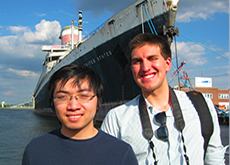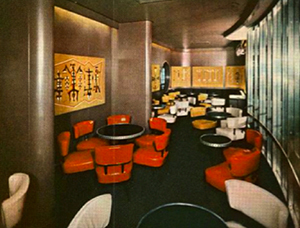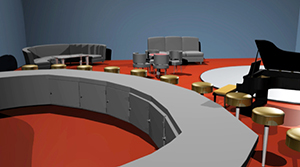An Iconic U.S. Passenger Ship in 3D
February 20, 2014
 Digital Media Prof. Glen Muschio and his Animation students have been applying talent and technology to creating digital cultural heritage, or recreating historic sites and artifacts in 3D. One of the most massive projects on their plate is a complete 3D digital rendering of a passenger ship that is 100 feet longer than the Titanic. The S.S. United States is an icon of mid-20th century industrial design docked in Philadelphia on the Delaware River. It is 990 feet long (or five city blocks) and more than 100 feet tall (12 decks), designed by Philadelphia-born naval architect William Francis Gibbs to be one of the fastest ships of its kind.
Digital Media Prof. Glen Muschio and his Animation students have been applying talent and technology to creating digital cultural heritage, or recreating historic sites and artifacts in 3D. One of the most massive projects on their plate is a complete 3D digital rendering of a passenger ship that is 100 feet longer than the Titanic. The S.S. United States is an icon of mid-20th century industrial design docked in Philadelphia on the Delaware River. It is 990 feet long (or five city blocks) and more than 100 feet tall (12 decks), designed by Philadelphia-born naval architect William Francis Gibbs to be one of the fastest ships of its kind.
Animation & Visualization Effects sophomores Zachary Stockmal and Justin Wu, both Drexel STAR Program students working under Muschio’s supervision, began working on a 3D rendering of the ship’s famous Navajo Lounge, which once hosted VIP guests such as Bill Clinton, Salvador Dali, Jackie Gleason and the Kennedys. The S.S. United States Conservancy, which eventually plans to transform the ship into a massive, fully functional hotel and conference center, is looking forward to the results coming from Prof. Muschio’s students. The organization is sponsoring a new S.S. United States exhibition at Philadelphia’s Independence Seaport Museum (211 South Columbus Blvd. and Walnut St.) opening March 7 that will include Prof. Muschio’s seniors’ 3D presentations. The exhibition, “SS United States: Charting a Course for America's Flagship,” spotlights the ship’s Philadelphia connection, its heyday during the 1950s and 1960s. The exhibition will be on display until Sept. 14.


The Navajo Lounge featured a series of 13 murals based on traditional Navajo Sand paintings. Stockmal and Wu modeled these paintings, as well as color palettes for furniture, based on photographs of ephemera, items and furnishings and architectural drawings.
“Zach and Justin’s work inspired my seniors to continue rendering the other areas of the ship,” said Muschio. “Together, their work creates an immersive 3D virtual tour of the ship’s interior. This was a massive, unique environment for the students to work with and it’s nothing like the luxury liners you see in the movies. Gibbs designed the S.S. United States for speed, so he gave technology priority in the construction. He used a lot of aluminum and lots of asbestos that had to be stripped.”
 Muschio said his seniors would have an animated tour "on rails" (meaning that the viewer travels through the animated space on a set course) ready in April, which will be included in the Independence Seaport Museum exhibit. “In June, we’ll have the full 3D tour ready and we’ll present it at the Digital Media senior show, making it available to attendees on provided iPads,” he said. “It’s a project that’s perfect for Philadelphia, which is a city built on historical icons. With these types of projects, we’re trying to add historical and educational research emphasis to Drexel’s Digital Media education and explore areas and applications beyond entertainment.”
Muschio said his seniors would have an animated tour "on rails" (meaning that the viewer travels through the animated space on a set course) ready in April, which will be included in the Independence Seaport Museum exhibit. “In June, we’ll have the full 3D tour ready and we’ll present it at the Digital Media senior show, making it available to attendees on provided iPads,” he said. “It’s a project that’s perfect for Philadelphia, which is a city built on historical icons. With these types of projects, we’re trying to add historical and educational research emphasis to Drexel’s Digital Media education and explore areas and applications beyond entertainment.”